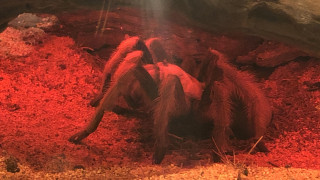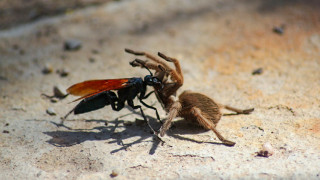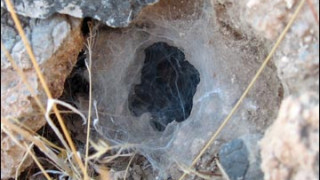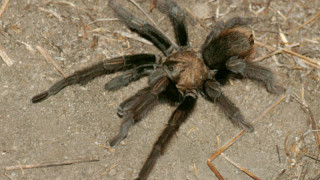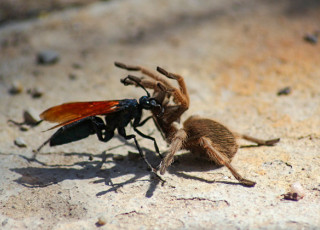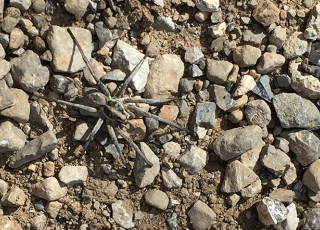Tarantula Sightings in Utah: Everything You Need to Know
By Olivia Barney
Tarantulas live all over the world — with over 900 species found across six continents. They’re some of the biggest and hairiest arachnids in the world, which makes them a popular feature in scary movies and haunted houses. But casting them as something to be feared is a misrepresentation. Many tarantulas, including those that live in Utah, prefer to stay far away from humans, living most of their lives underground. During the late summer and early autumn, however, male tarantulas leave their homes (burrows) in search of a mate. You’ll likely only see them in the desert or foothills, but if you happen to cross paths with one of these shy spiders, here’s everything you need to know.
Our Harmless Neighbors
Tarantulas are introverted and don't have many ways to defend themselves. They don’t have wings to fly away from danger. They don’t have stingers to fight back. And despite having eight legs, they’re also not particularly fast runners. So, if they can’t effectively fight or flee from predators, their best defense is staying hidden. Female tarantulas will only leave their burrow if it’s destroyed, and males typically only leave when searching for a mate. They don’t even leave home to find food.
Tarantulas hunt using a strategy called “door keeping.” Rather than leaving the safety of their burrow to find food, tarantulas sit just inside the entrance, waiting for prey to walk by. They’ll eat almost anything, as long as it’s small enough to not be a threat. If something small wanders too close to their door, tarantulas will jump out and pull their prey inside, allowing them to eat in the safety of their burrows. Tarantulas have tiny eyes, so they rely on vibrations in the ground to make sense of their surroundings. These vibrations alert them to approaching food as well as potential dangers.
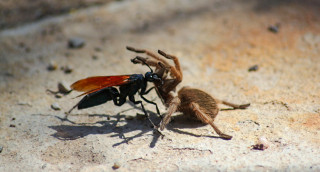
Tarantula Hawk Wasp and Tarantula
Utah’s tarantulas are hunted by many local predators, including coyotes, skunks, and fearsome tarantula hawk wasps. Even some snakes and lizards prey on tarantulas — though they have to be more careful in their approach. While tarantulas in our area don’t bite defensively, they will do their best to scare off potential threats. If frightened, tarantulas will kick irritating hairs off their abdomens into a predator's eyes. They may also rear up to try and make themselves look bigger.
Tarantulas in Utah
Utah’s most common tarantula is Aphonopelma iodius (sometimes known as the Salt Lake County Brown), which is a shy, slow-growing species. Males take about 10 years to fully mature, and females can live for around 25 years. Like other arachnids, tarantulas can make webs, but they don’t use them to catch food. Instead, they use their webs to line underground burrows in silk. These silky burrows become homes that protect them from the extreme temperatures often found in Utah’s desert landscape.
The Salt Lake County Brown is not dangerous to humans, so if you see one, it's best to leave it alone. If relocation is necessary, here are a couple of tips to protect both you and these gentle spiders from harm.
- Wear gloves — though tarantulas may not be a danger to humans, their barbed hair can irritate your skin. Wearing gloves prevents itching and irritation.
- Gently scoop it into a container and relocate to a shaded spot — please do so carefully! If dropped, a tarantula could die or become injured.
- Leave it in the wild — tarantulas should be left in their natural habitat whenever possible. Salt Lake County Brown tarantulas don’t want to become your pets; they would rather return to their safe, cozy burrows.
As the summer cools down and autumn leaves begin to fall, male tarantulas can be found across certain areas of Utah. If you spot one crossing your path, there’s no need to stress. Utah’s tarantulas aren’t interested in hurting you or invading your home. Give them their space and they will respect yours!
1 of 5
If you're interested in seeing a tarantula up close, visit our Life Exhibit — which is included in Museum admission and free for Museum Members. You can also encounter a variety of tarantulas at NHMU's annual BUGfest event, which brings together invertebrate experts, educators, and enthusiasts for a celebration packed with fun programming, collections showcases, live insect interactions, and more! Stay tuned for exciting details about BUGfest 2025.

